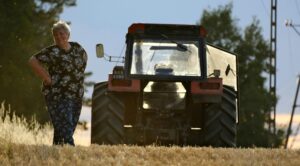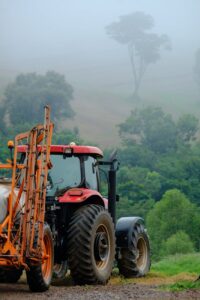The Cockshutt tractor stands as an enduring symbol of innovation and resilience in North American agricultural machinery history. Manufactured by the Cockshutt Plow Company, a Canadian agricultural equipment firm, these tractors were once revered for their durability, performance, and pioneering engineering features. From their early models to the more advanced series like the Cockshutt 550, the company carved a distinctive niche in the tractor industry.
This article delves into Cockshutt tractor history, iconic models like the 1365 Cockshutt tractor and 1650 Cockshutt tractor, and discusses where enthusiasts can find Cockshutt tractor parts today.
Cockshutt Tractor History: A Canadian Agricultural Icon
To understand the significance of the Cockshutt tractor, it’s essential to explore its historical context. The Cockshutt Plow Company was founded in 1877 in Brantford, Ontario, Canada. Initially, the company specialized in plows and other farm implements. As agriculture began to mechanize in the early 20th century, Cockshutt adapted by entering the tractor market—a move that would prove pivotal.
Their first significant tractor development occurred during World War II, a time when North American manufacturers were pushed to innovate. In 1946, Cockshutt introduced the Cockshutt Model 30, one of the first production tractors in North America with a live PTO (Power Take-Off), a revolutionary feature that allowed implements to operate independently of the tractor’s movement. This innovation cemented Cockshutt’s reputation for practical engineering.
Throughout the 1950s and 1960s, Cockshutt continued to produce a line of high-quality tractors. Despite being a relatively smaller player compared to giants like John Deere and International Harvester, Cockshutt tractors earned a loyal following among Canadian and American farmers for their reliability, performance, and ease of maintenance.
Cockshutt Tractor 550: A Mid-Sized Marvel
One of the standout models from the Cockshutt line is the Cockshutt tractor 550, a mid-sized utility tractor produced between 1958 and 1961. It featured a 4-cylinder gas or diesel engine and was known for its balance of power, versatility, and operator comfort.
What made the Cockshutt 550 especially popular among small to medium-sized farm operators was its ability to handle a wide range of tasks. From plowing and discing to planting and harvesting, the 550 proved to be a dependable companion. It was equipped with live PTO, power steering, and an optional hydraulic system, which made operating implements easier and more efficient.
The model’s streamlined design also made it stand out visually. With a stylish grille and distinctive paint scheme—typically red and cream—the 550 had a unique aesthetic appeal. Today, it remains a favorite among vintage tractor collectors and is frequently restored for display at agricultural shows and parades.
Cockshutt Tractor Parts: Restoring a Legacy
For collectors, restorers, and hobbyists, preserving the legacy of Cockshutt tractors means having access to authentic Cockshutt tractor parts. Given that the original company ceased tractor production in the 1960s, sourcing parts can be challenging but not impossible.
Several online retailers and tractor salvage yards in both the U.S. and Canada specialize in vintage tractor parts, including those for Cockshutt models. Some of the most commonly sought-after components include:
-
Engine parts (pistons, sleeves, crankshafts)
-
Carburetors and fuel systems
-
Hydraulic pumps and valves
-
Transmission gears and bearings
-
PTO components
-
Sheet metal (hoods, fenders, grills)
-
Tires and wheels
-
Electrical systems (starters, alternators, wiring harnesses)
In recent years, the vintage tractor restoration community has seen a resurgence, and with it, the reproduction of hard-to-find parts. Forums, Facebook groups, and local tractor clubs are excellent resources for locating both OEM and aftermarket parts. Many collectors also swap parts or trade surplus components from restoration projects.
When restoring a Cockshutt, authenticity matters to many enthusiasts. Ensuring that each part matches the original specifications helps maintain the tractor’s historical value and mechanical integrity.
The 1365 Cockshutt Tractor: A European Connection
The 1365 Cockshutt tractor represents a transitional phase in the brand’s history. By the mid-1960s, Cockshutt was acquired by the White Motor Company, which merged several brands, including Oliver and Minneapolis-Moline, under one corporate umbrella. As a result, many Cockshutt-branded tractors in the later years were badge-engineered versions of Oliver or imported tractors.
The 1365 was built by Fiat in Italy and sold under multiple brand names, including Oliver and Cockshutt. Despite the shift in manufacturing, the 1365 still carried the Cockshutt branding in the Canadian market.
Key features of the 1365 include:
-
A 3-cylinder Fiat diesel engine
-
Approximately 45 horsepower
-
8-speed transmission
-
Optional two- or four-wheel drive
This model was appreciated for its fuel efficiency, ruggedness, and easy maneuverability—traits that suited both small farms and specialty crop operations. While some purists lament the shift away from Canadian manufacturing, the 1365 nonetheless holds a respected place in Cockshutt tractor history as part of the brand’s evolution.
The 1650 Cockshutt Tractor: Power and Durability
Another model that commands attention is the 1650 Cockshutt tractor, which, like the 1365, was part of the White Motor Company’s lineup. Produced between 1964 and 1969, the 1650 was essentially an Oliver 1650 tractor rebadged for the Cockshutt market.
This powerful machine featured:
-
A 6-cylinder Waukesha engine (available in gas, diesel, or LP)
-
Approximately 66 PTO horsepower
-
Hydrostatic power steering
-
An optional Hydra-Power Drive (a two-speed power shift unit)
The 1650 gained popularity for its torque and reliability. It was particularly effective for larger-scale farming operations requiring powerful, durable machinery for tillage and harvesting tasks. The 1650’s versatility and rugged design ensured it remained in use for decades, and many units are still operational today.
Collectors value the 1650 for its sheer strength and the role it played in bridging Cockshutt’s independent design era with the White Motor Company’s consolidated approach. Though its origins are rooted in Oliver engineering, the Cockshutt 1650 retains the styling and branding elements that enthusiasts associate with the historic Canadian company.
The Decline of the Cockshutt Brand
Despite producing high-quality tractors and pioneering features like the live PTO, the Cockshutt brand couldn’t withstand the competitive pressures of the post-war agricultural machinery market. By the early 1960s, mergers and acquisitions began reshaping the industry. The White Motor Company’s acquisition of Cockshutt in 1962 marked the beginning of the end for the brand’s independence.
Under White’s control, Cockshutt tractors became increasingly badge-engineered versions of Oliver and Fiat models. Eventually, the Cockshutt name was phased out entirely by the early 1970s. Although the company continued in various forms in other industrial segments for a time, its tractor manufacturing legacy had concluded.
However, the end of manufacturing did not mark the end of interest in Cockshutt tractors. On the contrary, a vibrant community of collectors and enthusiasts remains committed to preserving and celebrating the brand’s legacy.
Why Cockshutt Tractors Still Matter Today
There are several reasons why the Cockshutt tractor retains its appeal decades after production ceased:
-
Innovation: Cockshutt was among the first manufacturers to introduce a live PTO, a feature that became standard in modern tractors.
-
Design: The unique styling and color schemes of Cockshutt tractors give them a distinct aesthetic, particularly models like the 550.
-
Durability: Built to last, many Cockshutt tractors are still in working condition and continue to serve on farms or appear at vintage machinery shows.
-
Community: From online forums to in-person events, the Cockshutt collector community is active, knowledgeable, and passionate about preserving this piece of agricultural history.
-
Historical Significance: As one of Canada’s major contributions to tractor development, Cockshutt holds an important place in North American agricultural heritage.
Frequently Asked Questions (FAQ) About Cockshutt Tractors
1. What is a Cockshutt tractor?
A Cockshutt tractor is a line of agricultural tractors originally manufactured by the Cockshutt Plow Company in Brantford, Ontario, Canada. These tractors were known for their innovation, particularly the early use of a live PTO (Power Take-Off) system. The company produced tractors from the mid-1940s to the early 1970s.
2. What is significant about Cockshutt tractor history?
Cockshutt tractor history is notable for several industry firsts, especially the introduction of the live PTO in the Model 30—one of the earliest North American tractors with this feature. Cockshutt remained independent longer than many Canadian manufacturers and produced a wide range of tractors that were popular among both Canadian and American farmers.
3. What is the Cockshutt tractor 550 known for?
The Cockshutt 550 is a popular mid-sized utility tractor known for its durability, live PTO, and attractive design. Produced between 1958 and 1961, it featured a 4-cylinder engine and was praised for its balance of power and versatility for small to medium farms.
4. Are Cockshutt tractors still in production?
No, Cockshutt tractors are no longer in production. The brand was absorbed by the White Motor Company in the 1960s, and the Cockshutt name was phased out by the early 1970s. However, many models remain in use and are highly sought after by collectors and restorers.
5. Where can I find Cockshutt tractor parts?
Cockshutt tractor parts can be found through:
-
Online vintage tractor parts suppliers
-
Tractor salvage yards
-
Farm equipment auctions
-
Collector forums and clubs Reproduction parts are also available for some of the more popular models like the 550, 1365, and 1650.
6. What engine does the 1365 Cockshutt tractor use?
The 1365 Cockshutt tractor was powered by a 3-cylinder diesel engine built by Fiat. The model was actually manufactured by Fiat in Italy and sold under several brand names, including Cockshutt in Canada.
7. Is the 1365 Cockshutt tractor Canadian-made?
No. Although it carried the Cockshutt brand in Canada, the 1365 was manufactured by Fiat in Italy. It was part of a later series of Cockshutt tractors that were rebadged imports after the company was acquired by White Motor Company.
8. How much horsepower does the 1650 Cockshutt tractor have?
The 1650 Cockshutt tractor delivered about 66 PTO horsepower and was powered by a 6-cylinder Waukesha engine. It was a rebadged version of the Oliver 1650 and was well-known for its power and reliability in heavy-duty farm operations.
9. What are some other notable Cockshutt tractor models?
Other popular Cockshutt models include:
-
Model 30 (first with live PTO)
-
Model 40 (larger version of the 30)
-
Model 50 (heavy-duty row-crop tractor)
-
Cockshutt 570 and 570 Super (high-horsepower models) Each of these tractors had its own engineering strengths and a specific target market.
10. Are Cockshutt tractors good for restoration projects?
Yes, many enthusiasts consider Cockshutt tractors ideal for restoration due to their solid construction, historical significance, and availability of parts for popular models. Tractors like the 550 and 1650 are especially favored among collectors.
11. Can I still use a Cockshutt tractor for farming today?
Absolutely. While modern tractors offer more technology and features, many Cockshutt tractors are still used on small farms today. They’re especially useful for hobby farming, mowing, plowing, and other general utility tasks.
12. Are there Cockshutt tractor clubs or communities?
Yes, there are several online and local Cockshutt tractor clubs in North America. These communities organize events, share parts sources, and provide support for restoration projects. Social media groups and vintage tractor forums are great places to start.
Conclusion
The story of the Cockshutt tractor is one of ingenuity, resilience, and legacy. From its humble beginnings as a plow manufacturer to its role as an innovative tractor producer, Cockshutt made lasting contributions to farm machinery. Iconic models like the Cockshutt tractor 550, 1365 Cockshutt tractor, and 1650 Cockshutt tractor serve as enduring symbols of a brand that prioritized farmer-friendly design and practical engineering.
Though the original company has long since vanished from the modern agricultural equipment landscape, its legacy is far from forgotten. Whether you’re a vintage tractor collector, a restoration hobbyist searching for Cockshutt tractor parts, or simply a history enthusiast, the story of Cockshutt offers rich insight into a remarkable era of farming innovation.
As long as there are those willing to preserve, repair, and celebrate them, Cockshutt tractors will continue to roll proudly through the fields of memory and heritage.



